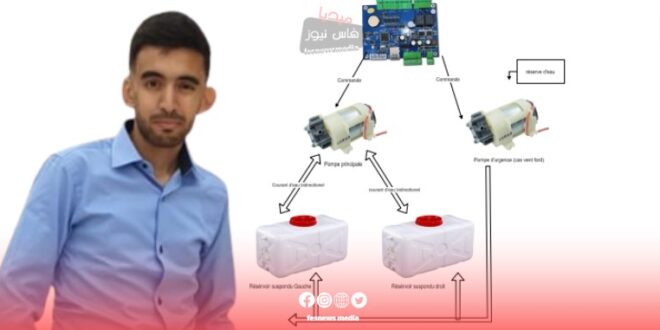Inventor Zakaria Hachem has introduced a new innovation in the field of solar energy: a low-cost hydraulic tracking system for floating solar panels. This invention aims to address two major issues in a world facing climate change: generating clean energy and conserving water.
The new system relies on water and gravity to control the tilt angle of solar panels towards the sun. The device consists of a water pump, reservoirs connected by cables, and a floating support structure that facilitates the movement of reservoirs and the rotation of solar panels.
To change the tilt angle, the pump extracts water from reservoirs on one side to reduce their weight, while simultaneously adding water to reservoirs on the other side. As a result, the heavier reservoir descends due to gravity, and since it is connected to the solar panels via a cable, the panels naturally tilt.
Key advantages of this system include:
- Lower cost compared to traditional tracking systems.
- Easy maintenance.
- Adaptability to various solar panel sizes and climate conditions.
- Low energy consumption due to the use of Earth’s gravity.
- Possibility of remote control and response to extreme weather events.
This innovation can be applied to a wide range of projects, including agricultural basins, floating solar parks, and most areas of photovoltaic energy.
It’s worth noting that this document is a draft patent application, available under the Creative Commons Attribution 4.0 International License (CC BY 4.0), allowing everyone to share and adapt the content with proper attribution to the original author.
The invention presents a solution for floating solar tracking based on gravity and water pumping. It includes solar panels, one or more water pumps, reservoirs attached to the solar panels by flexible cables, a floating support structure, and a free pivoting cylinder.
This system is considered autonomous or remotely controlled, with the ability to detect extreme events and respond appropriately. It provides total configurability for photovoltaic panel designers, with configurable elements including reservoirs, pumps, and the method and type of control.
The device can be applied for solar tracking in agricultural basins, floating solar parks, and virtually all actors in the field of photovoltaic energy, offering a promising solution for the future of renewable energy and water conservation.
 فاس نيوز ميديا جريدة الكترونية جهوية تعنى بشؤون و أخبار جهة فاس مكناس – متجددة على مدار الساعة
فاس نيوز ميديا جريدة الكترونية جهوية تعنى بشؤون و أخبار جهة فاس مكناس – متجددة على مدار الساعة













